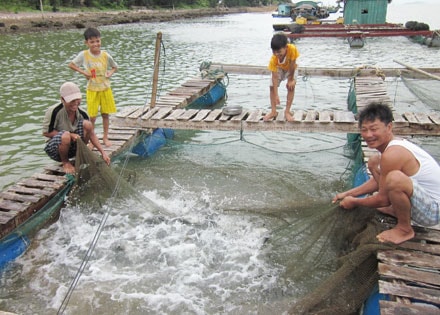Sticking to the sea by raising fish in cages
(Baonghean)-With the help and support of officers and soldiers of the Border Guard Station of Cua Lo - Ben Thuy Port, many fishermen of Nghi Thiet (Nghi Loc) and Nghi Tan (Cua Lo - Nghe An) communes have boldly invested and stuck to the sea by raising fish in cages...
The canoe of Nghe An border guards cut through the waves to take us to the red snapper and sea bass cages of Mr. Nguyen Van Ninh in Rong hamlet, Nghi Thiet (Nghi Loc - Nghe An). Stopping feeding the fish, Mr. Ninh said: In just over a month, if the weather is favorable, his fish cage with about 5,000 fish fry will initially yield about 4 tons, equivalent to 500 million VND. This is a dream number for fishermen who have been drifting on the sea with fishing boats for many years.
Along with Mr. Ninh, there are 12 other households in Nghi Thiet (Nghi Loc) and Nghi Tan (Cua Lo) who are also developing a model of raising fish in cages at sea, of which the household with the most fish is Mr. Nguyen Van Thai, also in Rong Nghi Thiet hamlet, with about 6,000 fish.

Fish cage of Mr. Nguyen Van Ninh, Rong hamlet, Nghi Thiet
Although the profession is new, the fishermen are not alone because they have the help, support, technical guidance as well as experience of the officers and soldiers of the Cua Lo - Ben Thuy Port Border Guard Station. The success of the cage fish farming model implemented by the Cua Lo Border Guard Station in collaboration with the Central Aquaculture Center in 2010 is the driving force that encourages fishermen to boldly change their profession...
Deputy station chief Nguyen Tien Dung - the person assigned to directly implement the pilot model of raising fish in cages at sea said: Cua Lo sea area has suitable depth, necessary salinity, clear water source, not polluted, very suitable for raising red snapper and sea bass. Therefore, in the first crop, the batch of fish raised by border guards brought in an income of 70 million VND. The two pioneer households that raised about 5,000 fish, Mr. An and Mr. Hai in Nghi Thuy and Nghi Tan wards, also had great success.
Raising fish in cages using industrial methods in the natural environment in the middle of the ocean is not difficult, it takes about 7 months to harvest. The main food of the fish is frozen fish heads, fish scraps are cut into small pieces depending on the age of the fish. However, it is necessary to pay attention to the water flow to ensure enough oxygen for the fish to grow and develop well, feed the fish on time, regularly, the cages must also be sturdy to withstand storms.
Although there are still many concerns, the sea cage fish farming has brought a stable income, creating opportunities for fishermen to escape poverty. Because the types of fish raised in sea cages are often species with economic value. Prices range from 100 - 150 thousand VND per kg and are imported to restaurants and hotels right in the area and neighboring areas, so there is no need to struggle to find an outlet. In the trend of expanding marine occupations and protecting increasingly depleted aquatic resources as today, the coastal cage fish farming model needs to be properly invested by the state and the fisheries sector, creating conditions for fishermen to receive techniques in a favorable way to form a fresh seafood export product with high economic value.
Khanh Ly - My Ha
